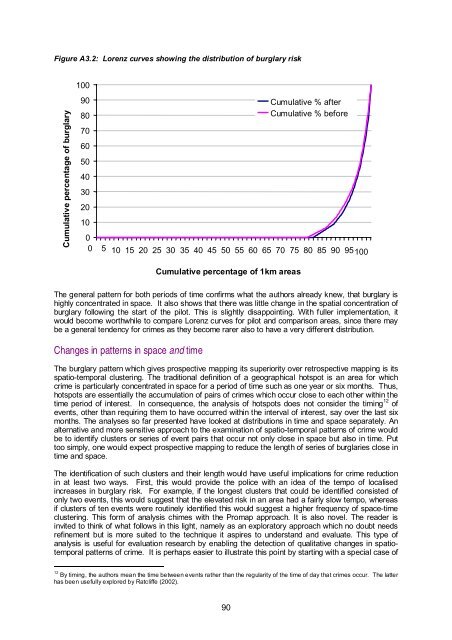Prospective crime mapping in operational context Final report
Prospective crime mapping in operational context Final report
Prospective crime mapping in operational context Final report
- No tags were found...
Create successful ePaper yourself
Turn your PDF publications into a flip-book with our unique Google optimized e-Paper software.
Figure A3.2: Lorenz curves show<strong>in</strong>g the distribution of burglary riskCumulative percentage of burglary100908070605040302010Cumulative % afterCumulative % before00 5 10 15 20 25 30 35 40 45 50 55 60 65 70 75 80 85 90 95100Cumulative percentage of 1km areasThe general pattern for both periods of time confirms what the authors already knew, that burglary ishighly concentrated <strong>in</strong> space. It also shows that there was little change <strong>in</strong> the spatial concentration ofburglary follow<strong>in</strong>g the start of the pilot. This is slightly disappo<strong>in</strong>t<strong>in</strong>g. With fuller implementation, itwould become worthwhile to compare Lorenz curves for pilot and comparison areas, s<strong>in</strong>ce there maybe a general tendency for <strong>crime</strong>s as they become rarer also to have a very different distribution.Changes <strong>in</strong> patterns <strong>in</strong> space and timeThe burglary pattern which gives prospective <strong>mapp<strong>in</strong>g</strong> its superiority over retrospective <strong>mapp<strong>in</strong>g</strong> is itsspatio-temporal cluster<strong>in</strong>g. The traditional def<strong>in</strong>ition of a geographical hotspot is an area for which<strong>crime</strong> is particularly concentrated <strong>in</strong> space for a period of time such as one year or six months. Thus,hotspots are essentially the accumulation of pairs of <strong>crime</strong>s which occur close to each other with<strong>in</strong> thetime period of <strong>in</strong>terest. In consequence, the analysis of hotspots does not consider the tim<strong>in</strong>g 12 ofevents, other than requir<strong>in</strong>g them to have occurred with<strong>in</strong> the <strong>in</strong>terval of <strong>in</strong>terest, say over the last sixmonths. The analyses so far presented have looked at distributions <strong>in</strong> time and space separately. Analternative and more sensitive approach to the exam<strong>in</strong>ation of spatio-temporal patterns of <strong>crime</strong> wouldbe to identify clusters or series of event pairs that occur not only close <strong>in</strong> space but also <strong>in</strong> time. Puttoo simply, one would expect prospective <strong>mapp<strong>in</strong>g</strong> to reduce the length of series of burglaries close <strong>in</strong>time and space.The identification of such clusters and their length would have useful implications for <strong>crime</strong> reduction<strong>in</strong> at least two ways. First, this would provide the police with an idea of the tempo of localised<strong>in</strong>creases <strong>in</strong> burglary risk. For example, if the longest clusters that could be identified consisted ofonly two events, this would suggest that the elevated risk <strong>in</strong> an area had a fairly slow tempo, whereasif clusters of ten events were rout<strong>in</strong>ely identified this would suggest a higher frequency of space-timecluster<strong>in</strong>g. This form of analysis chimes with the Promap approach. It is also novel. The reader is<strong>in</strong>vited to th<strong>in</strong>k of what follows <strong>in</strong> this light, namely as an exploratory approach which no doubt needsref<strong>in</strong>ement but is more suited to the technique it aspires to understand and evaluate. This type ofanalysis is useful for evaluation research by enabl<strong>in</strong>g the detection of qualitative changes <strong>in</strong> spatiotemporalpatterns of <strong>crime</strong>. It is perhaps easier to illustrate this po<strong>in</strong>t by start<strong>in</strong>g with a special case of12 By tim<strong>in</strong>g, the authors mean the time between events rather than the regularity of the time of day that <strong>crime</strong>s occur. The latterhas been usefully explored by Ratcliffe (2002).90
















